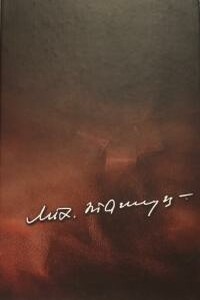The Run of His Life: The People v. O. J. Simpson - [22]
During the fall or winter of 1985 I responded to a 415 family dispute at 360 North Rockingham. Upon arrival I observed two persons in front of the estate, a black male pacing on the driveway and a female wht sitting on a veh crying. I inquired if the persons I observed were the residents, at which time the male black stated, “Yeah, I own this, I’m O.J. Simpson!” My attention turned to the female who was sobbing and asked her if she was alright but before she could speak the male black (Simpson) interrupted saying, “she’s my wife, she’s okay!” During my conversation with the female I noted that she was sitting in front of a shattered windshield (Mercedes-Benz I believe) and I asked, “who broke the windshield?” with the female responding, “he did (pointing to Simpson)… He hit the windshield with a baseball bat!” Upon hearing the female’s statement, Simpson exclaimed, “I broke the windshield… it’s mine… there’s no trouble here.” I turned to the female and asked if she would like to make a report and she stated, “no.”
It seems odd to remember such an event but it is not everyday that you respond to a celebrity’s home for a family dispute. For this reason this incident was indelibly pressed in my memory.
The author of the letter was Mark Fuhrman. Farrell passed it to the prosecutors, and on January 30 they decided to bring a case against O.J. Simpson.
As his lawyer, Simpson hired Howard Weitzman, a predictable choice given the latter’s reputation. Since winning an acquittal for John Z. DeLorean in a drug-possession case, Weitzman had run a well-publicized criminal and civil practice in Century City. Weitzman was also an active USC alumnus and big sports fan. In Simpson’s case, the lawyer quietly worked out a deal. First there would be several adjournments, which would diminish the already minimal media attention the incident had received. (The Los Angeles Times covered Simpson’s arrest with a 142-word story on page four of the sports section.) Weitzman arranged for Simpson to plead “no contest” to the charge-which is legally identical to “guilty” but sounds better in the press-in return for a sentence of probation and community service.
Weitzman pushed hard for Simpson. The day after Simpson made his plea, Weitzman filed a brief asking that Simpson’s case be “diverted.” Diversion is a legal process that allows a defendant, if he is not subsequently arrested, to lose the stigma of a criminal record. In his brief Weitzman observed, “Mrs. Simpson has indicated she did not want criminal charges filed against her husband nor will she voluntarily appear as a witness against her husband on behalf of the State.” This case, Weitzman wrote, involved a “minor physical injury (nonetheless significant to Mrs. Simpson) inflicted by a first-time offender who could be helped to refrain from repeating the offense with the proper counseling.” The city attorney objected to a diversion, however, and Simpson did in fact have to plea to the misdemeanor. On May 24, 1989, he received a suspended sentence, twenty-four months of probation, and fines totaling $470. He was ordered to “perform 120 hours of community service through the Voluntary Action Bureau” and to receive counseling twice a week. (Weitzman persuaded the prosecutor, Rob Pingel, to excuse Simpson from the customary group counseling sessions for batterers and instead allow him to receive his counseling from a private psychologist, Burton Kittay.) Finally, Simpson was directed to pay $500 as “restitution,” to the Sojourn Counseling Center, a battered women’s shelter in Santa Monica. (This was the same center that Nicole would call on June 7, 1994, five days before her death, to complain that O.J. was stalking her.)
Weitzman-and Simpson-did not cease playing the angles after the imposition of sentence. Simpson never reported to the Voluntary Action Bureau, which can assign convicts to such tasks as picking up trash by the highway or cleaning bedpans at hospitals. Instead, Simpson took it upon himself to select his own form of community service: organizing a fund-raiser for Camp Ronald McDonald, a children’s cancer charity, at the Ritz-Carlton Hotel in Laguna Beach, where O.J. and Nicole had a vacation home.
When Simpson went back to court on September 1, 1989, to report on the progress of his probation, his form of community service was questioned by the judge. Simpson’s response-indeed, his behavior at the hearing, where no journalists were present-was a mixture of indignation and self-pity.
“I want to know specifically what you did,” the judge, Ronald Schoenberg, asked the defendant.
“Everything,” said Simpson. “I closed up my office at the beginning of June and moved my office to Laguna. I created this affair. I didn’t just work for them. I created this affair. When my lawyer informed me before the sentence that I would have to do community service… in the spirit of all of this, I went out on my own and created this event. I talked everyone into it from Coca-Cola to-I flew to Atlanta. I flew to New York and met with Hertz. I flew to Boston to meet with sponsors like Reebok. I went to Ritz-Carlton, spent time with them to get them to pick up some of the cost of the event… I wrote personal letters and contacted corporate America to see if they would participate in this event… We put on what I felt was the finest event they ever had in that area. At least that’s what the press said.”

Книга представляет собой исследование англо-афганских и русско-афганских отношений в конце XIX в. по афганскому источнику «Сирадж ат-таварих» – труду официального историографа Файз Мухаммада Катиба, написанному по распоряжению Хабибуллахана, эмира Афганистана в 1901–1919 гг. К исследованию привлекаются другие многочисленные исторические источники на русском, английском, французском и персидском языках. Книга адресована исследователям, научным и практическим работникам, занимающимся проблемами политических и культурных связей Афганистана с Англией и Россией в Новое время.

"Великий человек, яркая личность, Божий дар Беларуси" - так Михаила Николаевича Пташука называли еще при жизни наши современники и с любовью отмечали его уникальный вклад в развитие отечественного, российского и мирового кинематографа. Вклад, требующий пристального внимания и изучения. "И плач, и слёзы..." - автобиографическая повесть художника.

Тюрьма в Гуантанамо — самое охраняемое место на Земле. Это лагерь для лиц, обвиняемых властями США в различных тяжких преступлениях, в частности в терроризме, ведении войны на стороне противника. Тюрьма в Гуантанамо отличается от обычной тюрьмы особыми условиями содержания. Все заключенные находятся в одиночных камерах, а самих заключенных — не более 50 человек. Тюрьму охраняют 2000 военных. В прошлом тюрьма в Гуантанамо была настоящей лабораторией пыток; в ней применялись пытки музыкой, холодом, водой и лишением сна.

В книге рассказывается история главного героя, который сталкивается с различными проблемами и препятствиями на протяжении всего своего путешествия. По пути он встречает множество второстепенных персонажей, которые играют важные роли в истории. Благодаря опыту главного героя книга исследует такие темы, как любовь, потеря, надежда и стойкость. По мере того, как главный герой преодолевает свои трудности, он усваивает ценные уроки жизни и растет как личность.

Брошюра написана известными кинорежиссерами, лауреатами Национальной премии ГДР супругами Торндайк и берлинским публицистом Карлом Раддацом на основе подлинных архивных материалов, по которым был поставлен прошедший с большим успехом во всем мире документальный фильм «Операция «Тевтонский меч».В брошюре, выпущенной издательством Министерства национальной обороны Германской Демократической Республики в 1959 году, разоблачается грязная карьера агента гитлеровской военной разведки, провокатора Ганса Шпейделя, впоследствии генерал-лейтенанта немецко-фашистской армии, ныне являющегося одним из руководителей западногерманского бундесвера и командующим сухопутными силами НАТО в центральной зоне Европы.Книга рассчитана на широкий круг читателей.

Книга Стюарта Джеффриса (р. 1962) представляет собой попытку написать панорамную историю Франкфуртской школы.Институт социальных исследований во Франкфурте, основанный между двумя мировыми войнами, во многом определил не только содержание современных социальных и гуманитарных наук, но и облик нынешних западных университетов, социальных движений и политических дискурсов. Такие понятия как «отчуждение», «одномерное общество» и «критическая теория» наряду с фамилиями Беньямина, Адорно и Маркузе уже давно являются достоянием не только истории идей, но и популярной культуры.